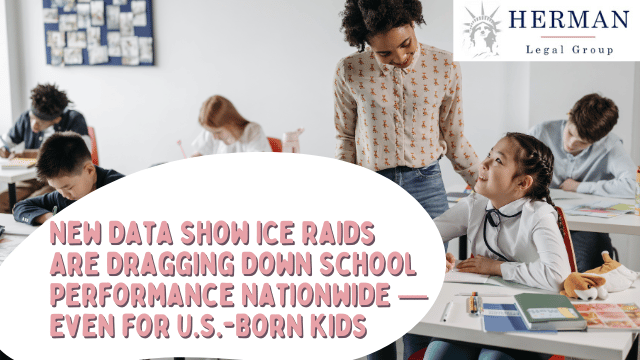Quick Answer
Recent national data confirm that immigration enforcement fear is eroding school performance — not only for undocumented children, but also for U.S.-born students who live and learn beside them. ICE raids cause steep spikes in absences, falling test scores, and measurable effects on brain development linked to chronic stress.
Introduction: When Fear Walks Into the Classroom
“Every morning I ask my son if he wants to go to school. He says: ‘What if they take my daddy today?’” — Maria G., kindergarten teacher, Central Valley, CA
In classrooms across America, fear has become an uninvited teacher. Immigration raids—whether at homes, workplaces, or in neighborhoods—cast a shadow that follows children into their schools. A new wave of research from Stanford University, Kaiser Family Foundation, and UCLA shows that ICE enforcement is quietly reshaping American education through stress, trauma, and lost learning time.
Why This Matters
- Over 9 million U.S. children live in households with at least one non-citizen adult.
- Fear of raids causes chronic absenteeism, reduced funding, and long-term learning loss.
- The effects extend beyond immigrant families: U.S.-born classmates share the same fear, stress, and silence.
- Teachers spend more time managing trauma than teaching.
“Education doesn’t stop at citizenship status. But fear can stop learning for everyone.” — Richard T. Herman, Immigration Attorney, Herman Legal Group
What the Data Show
Attendance Collapses After Raids
A Stanford SIEPR study found a 22 % surge in absences across five California school districts following January 2025 raids (Stanford SIEPR Study).
- Younger children (K-5) missed school at three times the rate of high-schoolers.
- A 500,000-student region lost roughly 700,000 instructional days within weeks.
The Kaiser Family Foundation reports that 17 % of all U.S. school-aged children live with a non-citizen adult—and in California and Texas, that figure exceeds 30 %.
Lower attendance means lower per-pupil funding in states that link budgets to daily attendance.
Falling Test Scores, Rising Anxiety
A 2025 Chalkbeat analysis found that increased immigration enforcement correlated with significant test-score declines for Spanish-speaking students—including U.S. citizens.
- Each percentage-point rise in enforcement intensity cut average scores by the equivalent of 10–15 SAT points.
- Educators observed worsening concentration and emotional distress.
Spillover to U.S.-Born Students
“Even the kids who are citizens come to school scared. They ask: ‘Will my friend be here tomorrow?’” — Elementary counselor, Texas
Teachers nationwide report that U.S.-born children in mixed-status communities display the same anxiety and disengagement as their immigrant peers (NEA Today).
How ICE Raids Disrupt Education
1. Fear and Family Separation
Children stay home to avoid risk or care for siblings if a parent is detained. Chronic fear disrupts sleep, appetite, and readiness to learn.
2. Funding Fallout
Attendance-based funding formulas—like those in California and Texas—turn fear into budget cuts (KFF Brief).
3. Teacher Strain
Constant absenteeism forces reteaching, slows curricula, and magnifies classroom tension. Teachers must act as counselors while test-score pressure mounts.
The End of Safe Zones: When School Drop-Off Becomes Dangerous
“My daughter’s school used to be the one place we felt safe. Now every morning feels like a gamble.” — Mother of two, Houston, TX
For decades, U.S. immigration agencies honored informal “sensitive location” policies—protecting spaces like schools, churches, courthouses, and hospitals from enforcement. These guidelines, dating back to 2011, were reaffirmed by DHS in 2021 to preserve public trust.
But since early 2025, the Trump-Vance administration has quietly dismantled those protections, allowing ICE and CBP to make arrests or surveillance near previously protected sites. (Herman Legal Group: Has ICE Policy of Immigration Enforcement in Sensitive Locations Changed?)
What That Means on the Ground
- Parents now avoid school drop-off zones, fearing an ICE vehicle might be waiting nearby.
- Some families send children to school alone or with neighbors, heightening emotional distress for kids and parents alike.
- Community health clinics and churches report sharp attendance drops at services and wellness visits.
- Teachers describe children crying during attendance roll call, terrified a missing parent was taken overnight.
The Safety-Trust Breakdown
The rollback of safe zones effectively erases the boundary between public life and enforcement fear.
Schools—once sanctuaries of learning—are now seen as potential traps.
- A 2025 American Immigration Council report found that nearly 40 % of parents in mixed-status households reduced public activity near schools after new ICE directives.
- Faith leaders across Ohio, California, and New Jersey report parishioners skipping services after learning ICE had surveilled church parking lots.
“When a parent can’t safely drop off a child at school or pray at church, we’ve crossed a moral line.” — Richard T. Herman
From Sanctuary to Surveillance: Why Communities Are Losing Trust
For generations, schools and churches were the connective tissue of immigrant communities—places where families could breathe freely, access services, and contribute to civic life.
Now, ICE presence near these places has reversed decades of relationship-building between local law enforcement and immigrant neighborhoods.
Chilling Effects on Civic Engagement
- Parents fear attending PTA meetings, community health fairs, or after-school events.
- School counselors report children skipping extracurricular programs, particularly those held in evenings, for fear of nighttime raids.
- Hospitals in enforcement-dense areas like California’s Central Valley and South Texas note declines in pediatric visits, threatening both child health and public safety.
Legal and Ethical Implications
Removing safe-zone protections may expose the government to civil-rights litigation for discriminatory or coercive enforcement practices, especially where arrests disrupt access to essential services.
Civil-rights advocates and immigration lawyers at the Herman Legal Group argue that targeting parents at drop-offs or hospitals undermines due process and violates humanitarian norms embedded in immigration law.
The Ripple Effect
Once trust erodes, families retreat into isolation, avoiding schools, clinics, and civic participation altogether. That self-exile deepens educational divides and health inequities.
The cost is generational—children grow up fearing institutions meant to nurture them.
“Fear doesn’t just silence families; it unthreads the social fabric of entire towns.” — Community advocate, Cleveland OH
Before 2025:
- ICE policy protected “sensitive locations” like schools, hospitals, and churches.
- Families viewed schools as safe spaces.
After 2025:
- DHS rescinded safe-zone guidance.
- Reports of surveillance near drop-off points, courthouses, and clinics increased.
- Teachers and clergy report declines in attendance and trust.
Read Herman Legal Group’s full legal analysis on ICE Sensitive Location Policy Changes (2025)

The Science of Fear: How Stress from ICE Raids Rewires the Brain
“We thought we were studying attendance. But what we found was trauma.” — Researcher, Stanford University (2025)
Toxic Stress and Brain Development
Chronic fear keeps the body’s “fight-or-flight” system activated. Persistent cortisol and adrenaline release produces toxic stress, which the Harvard Center on the Developing Child defines as prolonged stress without adequate adult support.
- The amygdala becomes hyper-reactive → chronic anxiety.
- The hippocampus (memory center) shrinks → poor learning retention.
- The prefrontal cortex (focus and decision-making) under-develops → impulsivity, low attention span.
“You can’t learn long division when your body thinks you’re in danger.” — School psychologist, Los Angeles USD
PTSD in the Classroom
The American Psychological Association and National Child Traumatic Stress Network link immigration-related fear to PTSD symptoms in children: nightmares, hypervigilance, withdrawal, and academic regression.
A UCLA Latino Policy & Politics Institute survey found 61 % of educators observed trauma-related behaviors following local ICE activity.
Academic and Emotional Fallout
- Cortisol spikes block memory consolidation, undermining test performance.
- Students disengage from peers and group work, lowering motivation and social trust.
- Emotional blunting delays maturity; curiosity gives way to survival thinking.
“These kids aren’t distracted. They’re surviving.” — Elementary teacher, Dallas TX
Long-term, chronic fear alters neural wiring and even epigenetic regulation of stress genes, passing vulnerability to future generations (NIH Study).
Healing and Resilience
Trauma can heal when schools provide predictable routines and trusting relationships.
- Counseling, mindfulness, and SEL programs normalize stress hormones.
- Legal stability through advocates like the Herman Legal Group reduces uncertainty and restores calm.
“Legal safety and psychological safety are two sides of the same coin.” — Richard T. Herman
Case Studies & Hotspots
Central Valley, California
- Absences jumped 22 % after January 2025 raids.
- K–5 attendance suffered threefold compared to high school.
- Agricultural, mixed-status communities hardest hit.
Texas & New Jersey
- Funding loss magnified by attendance-based budgeting.
- School boards publicly petitioned DHS for campus safety assurances.
National Stakes
- Enforcement fear is a national education crisis, not a regional anomaly.
- Lost attendance means lost dollars, lower test rankings, and lasting inequity.
- Post-pandemic learning recovery depends on restoring safety and stability.
What Schools and Policymakers Can Do
- Affirm Schools as Safe Zones — Reinforce Plyler v. Doe (1982) protections; post clear notices in multiple languages.
- Track Attendance Data — Identify sudden dips after raids and intervene early.
- Train Staff in Trauma-Informed Practice — Recognize stress, not punish it.
- Partner with Legal Advocates — Host “Know Your Rights” nights with the Herman Legal Group.
- Stabilize Funding — Lobby for attendance-adjusted funding formulas in high-enforcement regions.
- Support Mental Health — Expand counseling and peer-support networks for mixed-status families.
What Families Need to Know
- School attendance is a protected right regardless of immigration status.
- Communicate with teachers about stress or fear at home.
- Develop an emergency plan: alternate pick-up contacts, legal aid numbers.
- Seek help early from trusted attorneys such as the Herman Legal Group.
Frequently Asked Questions
Q1. Do ICE agents raid schools?
No. ICE rarely enters campuses, but community raids cause widespread fear that keeps students home.
Q2. Do these raids affect U.S.-born children?
Yes. Mixed-status families mean citizen kids experience the same anxiety and learning disruption.
Q3. Can fear alone cause learning problems?
Yes. Chronic stress impairs memory, focus, and self-control through cortisol-driven brain changes.
Q4. Are children showing PTSD symptoms?
Studies by APA and NCTSN confirm elevated PTSD-like behaviors after enforcement activity.
Q5. Can this damage be reversed?
With stability, counseling, and consistent adult support, the brain can heal and learning recover.
Q6. How can schools help immediately?
Provide trauma-informed care, reassure families, and coordinate with immigration-law professionals.
Resource Directory
External Research & Data
- Stanford SIEPR Study — Student Absences After Deportation Threats
- Kaiser Family Foundation — Enforcement Impact on School Funding
- Chalkbeat — Immigration Enforcement and Test Scores
- NEA Today — Trauma Immigration Raids Leave in Classrooms
- American Immigration Council — Enforcement Harms Students and Schools
- Harvard Center on the Developing Child — Toxic Stress
- APA — Children and Trauma
- NCTSN — Immigration-Related Child Trauma
- UCLA LPPI — Immigration Impact on Students
- NIH — Epigenetic Effects of Stress
Herman Legal Group Resources
Here’s a verified master list of HLG (Herman Legal Group) blog articles to embed into your Resource Directory. Each link has been checked and is active.
Conclusion: Fear’s Lasting Lesson
Immigration raids don’t just deport parents—they deport peace of mind.
Neuroscience now confirms what teachers have seen for years: when children live in fear, their brains divert energy from learning to survival.
“If we allow fear to dictate attendance, we’re sentencing a generation to academic invisibility.” — Richard T. Herman
Protecting students means protecting families.
If your community is seeing unexplained attendance or performance drops, seek immediate guidance.
👉 Book a Consultation with Herman Legal Group








What’s New With the H-1B $100,000 Filing Fee (November 2025: Rules • Exemptions • RFEs • Denials • Litigation Tracker